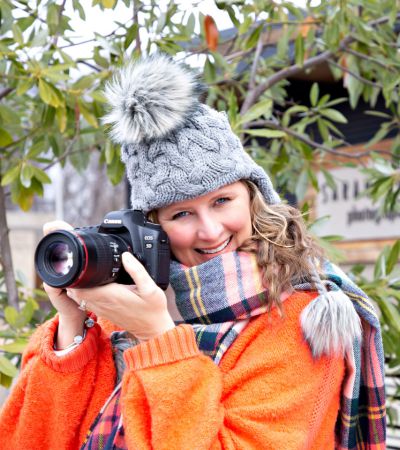This week, my top group of coaching students at the Photography Business Institute wrapped up a framework we lovingly call “Planuary.” I believe in this framework so much that we spend over 9 hours in January working through this framework together. This truly separates photographers who succeed versus photographers who struggle. I want to walk you through the same framework that these successful photographers use so you can make sure you’re looking at the right things when you plan your year out for your portrait photography business.
I love this saying, “Failing to plan is planning to fail.” How can you expect to get somewhere if you don’t make a plan? You don’t stumble upon a successful business. If you’re overwhelmed with what to do next, it’s probably because you’re failing to plan. So each year, we kick off the year with my Peak Performance students who are working toward their certified boutique photographer certification with one of my favorite events, “Planetary”.
I created “Planuary” because I saw the needs of my students to understand what marketing and business planning look like. The rest of the year, especially late in the year, they need to be focusing on revenue versus stopping and creating a detailed plan. It only makes sense in “Planuary” because we have a clean slate to start with and it’s more intensive than just hoping for more clients this year. I’ve seen firsthand the benefits of “Planuary” each year as our students are making more and more in their businesses. This year, we added three more hours to the training to help the students not just create their annual plan, but reinforce it by sharing each step with others in the group as we went.
After “Planuary,” the students not only have the confidence of knowing how they’re going to hit their financial goal, they know exactly what they’re going to be doing. Our intensive “Planuary” training is spread out over the entire month of January, with the premise that we have just come off our busy season as portrait photographers. This is our slower time of year when we have to take time to fix and plan so that we can run faster and more smoothly in the upcoming year. For the students who have been in our program for multiple years, every year when they do “Planuary”, they can see how much more they have grown from the year before. They’re understanding cash flow management more each year, and the importance of having a plan for seasonality and whatever obstacles might come up for them.
I want to share with you how I always approach “Planuary.” As a former ad agency marketing director, it was my job to put together their detailed marketing strategy for the year, and we worked with a very diverse client base. It was like this big strategy puzzle for each and every client and this is where I honed my skills as a marketer because it wasn’t just the same thing. Everybody had different goals and objectives, which is what made it fun. The more I did it, the more I built skills that I could take from one client and tweak the strategy a little bit and have an amazing plan, and it wasn’t just guessing. It was based on solid proof of what had worked at that agency.
Next, the team and I would take the strategy and the tactics and the creative team would come together and create the plan that supported the strategy, and most people do this wrong. They realize that they don’t have any clients or a marketing strategy, so they pick some tactics. We’ll call those tactics spaghetti because they throw them at the fridge and to see what sticks. Most of the time, there might be a strand of noodle that sticks and then it wiggles down and falls to the ground. And then when the spaghetti doesn’t stick, they take it personally or they assume it failed because of what they did.
Most of the time it’s because they don’t have a strategy or a plan. The strategy has to come first and then the tactics come second. Here are six steps that our process entails…
- Family First
We start with a family first filter. This is what gets me out of bed every day and what motivates me to serve you photographers so hard. I had parents who had that philosophy and I made that my mission when I had my kids and I want it for all of my students. The first thing we do in “Planuary” is everyone gets a 12-month calendar. That 12-month at a glance is where they can mark off their family activities. Things like your kids’ spring break, travel as a family, holidays, etc. Cross those dates off first, it’s so important. We do that so that we can enjoy the family time and we can put the business strategy second.
- Big Rocks
The next thing we do is we give everyone a line graph of the year where they can look at each month from a high level and put in the proverbial big rocks onto their plan. These are the big activities that take more time. We call them big rocks because you can’t put this together in an hour. They have gorgeous graphic design and they often have partners in many moving parts.
We give our students over 20 detailed strategic activities to choose from, but still, these things must have a runway for them to get off the ground. Even though I’m the one that hired the professional graphic designer, wrote up the strategy and rationale and all the detailed tactical steps to each activity, they still need to plan for that to happen. What we do is I encourage them to pick one big rock per quarter at the most because if they do this one activity really well, they can make the money they need for their quarter, which is amazing. Then in Planuary, what is so powerful is that we put them into small groups where they share their big rocks with other people. That way, if they’re stuck or they’re not really confident that that’s the one they want to pick, other people are there to encourage them or help them change what they are doing.
- Small Rocks
You can’t fill your jar up with small rocks and water because then the big rocks don’t fit in. So there are lots of small rocks, but let me give you one example because these are the smaller activities that support the big rocks, but they don’t take as big of a runway to happen. These activities are things like generating clients every month by donating to local charitable auctions. We teach this in one of our pathways so you know exactly how to do it, what the offer is, what to say, how to train the volunteer, how to make sure every client comes in and orders your average and is thrilled and gushes on you and loves you and refers to you
- Water
We talk about the water activities which are the little things that fill in the gaps. We have a monthly training for our students, literally called Hype. They each stand for something different that needs to happen as water activities when you can fill them in. We give them social media posts and ideas for the month based on what is happening that month. These are timely social media activities that fit in-between other activities. They’re always happening in the background to build community and to keep top of mind awareness for everybody.
- 30, 60, 90
I’m talking about days here. The next step is going from a high level strategy down to tactics where we break the big rocks and even the small rocks into action steps. If I’m partnering with a charity, what are the tactics that go into that? From picking the charity to creating the offer, to what is the promotional campaign? What are all of those things? So we break down all of those activities into bite size, step-by-step action steps. We do this in a framework we call 30, 60, 90, where we break down not just for the next one month, but for the next three months by month, so we know what we’re doing this month, the next month and the next month, and then when a month goes by, it rotates.
- 7, 7, 7
So we went from our 30, 60, 90 day plan based on the big rocks, the small rocks in the water. We just keep starting super high level and we’re moving our way down to more detail. And a great plan that isn’t executed because of paralysis by analysis isn’t going to work either. So we took each activity from just the next 30 days and we had them break it down into our 7, 7, 7 framework so they know what to do. The next seven days, seven minutes and seven seconds. Imagine what that would feel like to not only know what your year plan is, but your 90-day plan, your 60-day, your 30-day, your 7-day, your 7-minute and your 7-second plan? That is what it takes to create a plan that is custom to you and gets you moving immediately. When you take something that’s big and overwhelming and you just keep chunking it down until it’s one bite at a time, then before you know it, you have a business plan.
I think the challenge in the market is that most people teaching photographers have no training on the difference between solid marketing strategy versus tactics. They’re suggesting things like mini sessions, discounts, or giving digital files without having a correct strategy behind it. You don’t have to compete on price and attract clients that way. Truly, I think at the Photography Business Institute, we have the formal education that backs the strategy that you need to build a business when there’s an oversaturated market of people who are very much competing on price. It’s a brutal industry to be in, but one that you can very easily separate yourself from if you get out of the price race to the bottom, that’s where the competition is.
My friend, if you aren’t planning to succeed, you aren’t going to succeed. That’s the bottom line. Once you do it the right way once, you’ll get more and more confidence to do it again. I hope this has helped you see that planning has to start with strategy and then tactics, all along putting in the big rocks, the middle rocks, the water, all of the activities in that order using a family first filter.
Download the Episode Transcript Here









